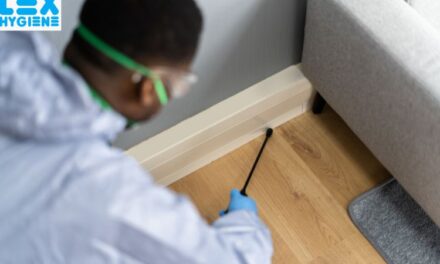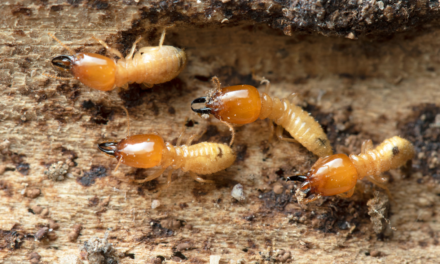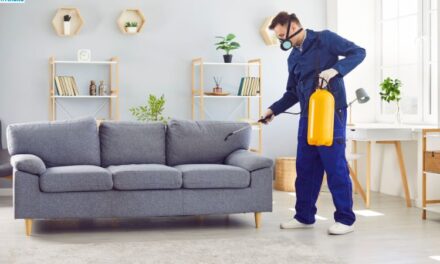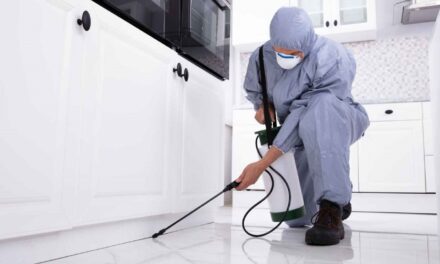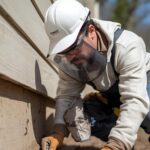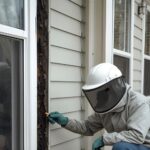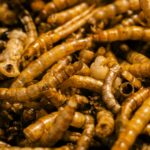Estimated reading time: 12 minutes
Key Takeaways
- Termites pose a *silent but devastating* threat to commercial properties, causing extensive structural and financial damage.
- Proactive prevention is paramount, far outweighing the cost of repairs after an infestation.
- Key preventive measures include meticulous *moisture control*, diligent *exterior maintenance*, sealing all potential *entry points*, and scheduling *regular professional inspections*.
- Recognizing subtle signs of termite damage like mud tubes, discarded wings, and hollow-sounding wood is critical for early detection.
- DIY treatments are generally *ineffective*; professional intervention with methods like liquid barriers, bait systems, or fumigation is necessary for effective eradication.
- Choosing a licensed, experienced, and reputable termite control company is essential for long-term protection and peace of mind.
Table of contents
- How to Prevent Termite Infestation: A Comprehensive Guide for Commercial Buildings
- Key Takeaways
- The Hidden Threat: Why Commercial Buildings are Termite Targets
- Comprehensive Strategies: How to Prevent Termite Infestation
- Spotting the Enemy: Signs of Termite Damage in Commercial Buildings
- Professional Solutions: Termite Treatment Options for Businesses
- Choosing the Best Termite Control Company in Delhi (and Beyond)
- Conclusion
- FAQ
Imagine a silent army, working tirelessly, day and night, to slowly dismantle your most valuable business asset from the inside out. This isn’t a scene from a movie; it’s the very real and often unseen threat of a termite infestation. These tiny pests can cause massive damage to commercial properties, leading to significant financial losses and operational headaches. A termite infestation occurs when colonies of these destructive insects establish themselves within a structure, feasting on cellulose-based materials like wood, paper, and fabric. The severity of such an invasion can be astounding, weakening foundations, compromising structural integrity, and even forcing businesses to halt operations.
That’s why understanding how to prevent termite infestation in commercial properties is not just important – *it’s absolutely critical*. Proactive prevention and swift action can save your business from becoming another termite statistic. This comprehensive guide will equip you with the knowledge needed to safeguard your commercial assets. We will explore why your buildings are prime termite targets, detail effective prevention strategies, teach you how to identify the subtle signs of termite damage in commercial buildings, discuss various professional treatment options, and finally, guide you on selecting the best termite control company in Delhi or any other location. Our goal is to provide a definitive resource for every commercial property owner and manager seeking to protect their valuable investments.
The Hidden Threat: Why Commercial Buildings are Termite Targets
Vulnerability of Commercial Structures
Commercial buildings are highly susceptible to termite attacks due to several inherent characteristics:
- Large Footprint and Complex Structures: The sheer size and intricate design of commercial buildings provide numerous entry points and hidden pathways for termites to exploit. Unlike smaller residential homes, these larger structures have vast areas that are rarely disturbed, offering ample undisturbed space for termite colonies to grow.
- Diverse Building Materials: While termites are known for eating wood, their diet is not limited to timber. Commercial buildings often contain a wide array of cellulose-rich materials that serve as abundant food sources. This includes not only wooden framing, beams, and doors but also paper records, cardboard boxes, furniture, insulation, and even certain types of fabrics. These materials offer an *all-you-can-eat buffet* for a hungry termite colony.
- Hidden Areas and Limited Access: Many commercial properties have hidden areas such as attics, crawl spaces, utility tunnels, basements, and service ducts. These spaces are typically less frequently accessed and inspected compared to main office areas. This lack of regular monitoring provides termites with ideal conditions to establish and expand their colonies undetected for long periods, leading to extensive, unseen damage before anyone realizes there’s a problem.
- Moisture Issues as a Primary Attractant: Termites, especially subterranean termites (which are the most common and destructive type), absolutely need moisture to survive and thrive. Commercial buildings often have extensive plumbing systems, large HVAC (heating, ventilation, and air conditioning) units, and sometimes flat roofs, all of which are potential sources of moisture. Leaks from pipes, condensation lines from air conditioners, or roof leaks can create ideal damp conditions that draw termites in and allow them to flourish. University extension services frequently highlight moisture as a primary attractant and emphasize that any cellulose material is a potential food source for termites. The National Pest Management Association (NPMA) stresses the hidden nature of infestations, making commercial properties particularly vulnerable to extensive, unseen damage. [Source: University of Florida IFAS Extension, Virginia Tech Entomology, NPMA]
Significant Financial and Operational Impact
- Expensive Structural Repairs: The most direct cost comes from repairing the physical damage. Termites can chew through wooden supports, floor joists, wall studs, and ceiling beams, compromising the structural integrity of the building. These repairs are often complex, requiring specialized contractors, and can be incredibly costly, easily running into tens or even hundreds of thousands of dollars depending on the extent of the damage. Replacing entire sections of a building’s framework or foundation is a *massive undertaking*.
- Replacement of Damaged Inventory and Equipment: Beyond the building itself, termites can destroy inventory, important paper records, documents, books, wooden furniture, and even electrical wiring insulation. For a retail business, this could mean unsellable goods; for an office, it could mean the loss of vital archives. The cost of replacing these items adds up quickly.
- Potential Operational Downtime: In severe cases, a termite infestation can force a business to shut down temporarily while repairs or treatments are carried out. This loss of operational time translates directly into lost revenue, decreased productivity, and potential disruption to client services. Imagine a hotel having to close rooms or a restaurant being unable to operate its dining area due to pest control activities.
- Indirect Costs and Reputational Damage: The financial repercussions also include indirect costs. A known pest problem can lead to a significant loss of tenant trust, especially in multi-tenant commercial properties. Tenants may seek to break leases or refuse renewals, leading to vacancy rates. Furthermore, the property’s market value can decrease significantly. Perhaps most damaging is the hit to a business’s reputation. News of a pest problem can spread quickly, deterring potential clients, investors, or employees. This can *erode brand image and market standing*, which is incredibly difficult to recover.
- Prevention Outweighs Repair: It’s crucial to understand that the costs associated with repairing severe termite damage almost always far exceed the expense of preventative measures or early intervention. Investing in robust pest management strategies and knowing how to prevent termite infestation is a wise financial decision that protects your assets in the long term. The NPMA estimates that termites cause over $5 billion in property damage annually in the U.S. alone, much of which affects commercial properties. Commercial real estate journals and property management guides consistently warn about the depreciation of asset value and business interruption risks due to pest issues. [Source: NPMA]
Comprehensive Strategies: How to Prevent Termite Infestation
Effective termite prevention is not a one-time fix; it’s a multi-faceted approach involving ongoing proactive maintenance, diligent environmental control, and smart landscaping. By implementing these strategies, you significantly reduce the risk of an invasion and fortify your commercial property against these wood-destroying pests. These measures directly address how to prevent termite infestation by eliminating attractants and sealing potential entry points.
Moisture Control & Drainage
Termites, especially the highly destructive subterranean species, cannot survive without moisture. Managing the moisture levels around and within your commercial building is perhaps the single most critical step in discouraging their presence. They are drawn to damp soil and humid environments.
- Promptly Repair All Plumbing Leaks: This includes leaky pipes, dripping faucets, overflowing toilets, and malfunctioning HVAC condensation lines. Even small, constant drips can saturate the surrounding soil or building materials, creating an *inviting oasis* for termites. Regularly inspect all visible plumbing and promptly address any signs of dampness.
- Repair Roof Leaks and Keep Gutters Clear: A leaking roof can allow water to seep into walls and ceilings, creating hidden pockets of moisture that are perfect breeding grounds for termites. Ensure your roof is in good repair and that gutters and downspouts are clean and free of debris. Clogged gutters can overflow, directing water directly against your foundation, which is exactly what termites want.
- Ensure Proper Exterior Drainage: Your building’s immediate surroundings should always direct water away from the foundation. The soil around the perimeter of your building should be graded (sloped) so that water naturally flows away. A slope of at least 6 inches per 10 feet is recommended. This prevents water from pooling against the foundation, which can soften the soil and create easy access for subterranean termites.
- Direct Downspouts Away from the Building: Extend downspouts at least 2-3 feet away from the foundation. Better yet, consider installing splash blocks or underground drainage pipes to carry water even further away. This prevents concentrated moisture accumulation near your building’s base.
- Improve Ventilation in Crawl Spaces and Basements: These enclosed, often dark areas are naturally prone to high humidity. Proper ventilation can significantly reduce moisture levels. Consider installing vents, fans, or even industrial-grade dehumidifiers in these spaces to keep the air dry and unwelcoming to moisture-loving termites. All leading entomological extension services universally identify moisture management as the single most critical preventative step. [Source: Purdue University, Clemson University]
Exterior Maintenance & Landscaping
The area immediately surrounding your commercial building acts as its first line of defense. By reducing readily available food sources and creating a dry, clear zone, you make your property less appealing to foraging termites. This involves both vigilant maintenance and thoughtful landscaping.
- Eliminate Wood-to-Ground Contact: This is a major attraction for termites. Any wooden structure – whether it’s a deck, fence, wooden siding, support posts, or even a decorative pergola – should not be in direct contact with the soil. Ensure there is a gap, ideally a few inches, between wood and the ground. For necessary ground contact, always use pressure-treated wood, which is chemically resistant to termites and rot. Regularly inspect any existing wood-to-ground contact points for signs of deterioration or termite activity.
- Maintain a Clear, Vegetation-Free Zone Around the Foundation: Create a buffer zone of at least 6-12 inches around the entire perimeter of your building’s foundation. This means removing mulch, dense shrubs, ivy, and other vegetation that can trap moisture against the foundation and provide hidden pathways for termites to climb up into your building. Replace wood-based mulch with less appealing alternatives like gravel or rubber mulch.
- Trim Trees and Shrubs: Ensure that tree branches and shrubs do not touch the building’s exterior walls or roof. Overhanging branches can provide “bridges” for arboreal termites (less common but possible) or allow access for drywood termites. They also create shaded, damp areas that can hide subterranean termite activity. Maintain a healthy distance between greenery and your structure.
- Remove All Dead Wood and Cellulose Debris: This includes old tree stumps, fallen branches, excess firewood, discarded lumber, and any other wood or cellulose-based debris. Termites will happily feast on these items first, and if they are close to your building, it’s an easy transition from the yard into your structure. Store firewood off the ground and at least 20 feet away from the building. The Environmental Protection Agency (EPA) and various state agricultural departments provide guidelines on creating a “defensible space” around buildings to deter pests. [Source: EPA]
Sealing Entry Points
Termites are incredibly resourceful and can squeeze through very tiny cracks and openings – some species only need a gap as thin as a business card. Sealing these potential entry points is a crucial physical barrier strategy.
- Regularly Inspect and Seal Foundation Cracks: Routinely walk around your building and inspect the foundation, concrete slabs, and exterior walls (including brick mortar) for any cracks, no matter how small. Use high-quality caulk, mortar, or concrete repair materials to seal these openings. Pay close attention to areas where concrete meets soil or where different building materials join.
- Seal Gaps Around Utility Penetrations: Pipes, electrical conduits, gas lines, and other utility lines often penetrate the building’s foundation or walls. Ensure that the spaces around these entry points are completely sealed. Termites can use these small gaps as highways directly into your building’s interior walls. Use appropriate sealants or expanding foam designed for exterior use.
- Ensure Windows and Doors are Properly Sealed: While termites typically enter from the ground, drywood termites can sometimes fly into buildings through open windows or unsealed gaps. Check that all windows and doors are properly fitted with weatherstripping and that any gaps around their frames are sealed with caulk. This also helps with energy efficiency, a *double win*. Pest control industry best practices, as outlined by organizations like the Professional Pest Management Alliance (PPMA), emphasize thorough sealing as a physical barrier. [Source: PPMA]
Regular Professional Inspections
Even with the most robust preventative measures, vigilance is key. Termites are notoriously stealthy, and early detection is paramount to mitigating damage. Professional inspections are an invaluable part of how to prevent termite infestation from becoming a catastrophe.
- Schedule Annual or Bi-Annual Inspections: Make it a priority to have your commercial property inspected by a licensed pest management professional at least once a year, or even twice a year if your business is in a high-risk area or has a history of pest issues. These experts have the training and tools to spot *subtle signs* that an untrained eye would easily miss.
- Expert Identification and Proactive Recommendations: Professional inspectors know where to look for termites – often in hidden areas like inside walls, behind baseboards, or in dark, undisturbed spaces. They can identify the specific species of termite, which influences the risk level and the most effective prevention or treatment strategies. They can also recommend proactive treatments, like preventative barrier treatments or bait systems, if your property is deemed to be at high risk due to its construction, location, or surrounding environment. Their expertise is crucial for truly comprehensive pest management. The NPMA strongly recommends routine professional inspections, particularly for commercial properties, given the scale and complexity of potential infestations. [Source: NPMA]
Spotting the Enemy: Signs of Termite Damage in Commercial Buildings
Early detection is paramount to minimizing the cost and extent of termite damage. While these pests are masters of concealment, they do leave behind specific clues that indicate their presence. Recognizing these signs of termite damage in commercial buildings is the first step toward effective intervention. Don’t ignore even the slightest hint of these indicators.
Mud Tubes
Perhaps the most definitive sign of subterranean termite activity is the presence of “mud tubes.”
- Description: These are pencil-sized (about 1/4 to 1 inch wide) tunnels made by termites from soil, wood particles, and their own saliva and feces. They look like veins of dirt running across surfaces.
- Location: You’ll typically find them on foundation walls, concrete slabs, support beams, pipes, or even rising from the ground up to wooden structures. They can also be found in less obvious places, such as behind baseboards or inside wall voids.
- Purpose: Subterranean termites require high humidity and protection from dry air and predators (like ants) as they travel between their underground nest and their food source (your building’s wood). Mud tubes serve as *protected highways*, maintaining the moist environment they need to survive. If you break open a tube and see tiny, ant-like insects crawling inside, you have found active termites.
Discarded Wings
The presence of discarded wings is a clear indicator that a termite colony is active and attempting to establish new colonies, often very close by.
- Swarming Event: Reproductive termites, known as “alates” or swarmers, emerge from mature colonies to mate and establish new ones. This usually happens during specific seasons (often spring or after heavy rains), but can occur any time indoors.
- Appearance: After their brief mating flight, these swarmers shed their wings, which are small, translucent, and often *shimmery*. They look like tiny fish scales.
- Location: You’ll typically find piles of these discarded wings near windows, doors, light fixtures, or vents – anywhere swarmers might attempt to exit or enter. They might also collect in spiderwebs. Finding these wings, even just a few, means there’s an active termite colony either inside your building or very close by.
Damaged Wood
The most destructive evidence of termites is the damage they inflict on wooden elements, though this often goes unnoticed until the problem is severe.
- Hollow Sound: Tap on wooden structures with a screwdriver handle. If the wood sounds hollow or dull instead of solid, it’s a strong indication that termites have been feasting on the interior, leaving only a thin veneer of wood or paint.
- Visible Distortion: Look for buckling wooden floors, sagging ceilings, distorted door or window frames. These issues can arise as termites tunnel through and weaken the internal structure of the wood. The wood may also appear darker or blistered, *resembling water damage*.
- Tunnels/Galleries: If you have any exposed wood, such as in basements, crawl spaces, or unfinished areas, look for visible tunnels or galleries (networks of pathways) within the wood itself. These are the routes termites create as they eat.
Frass (Termite Droppings)
While subterranean termites primarily leave mud tubes, drywood termites (which do not need contact with the soil) leave behind a different calling card: frass.
- Type of Termite: Drywood termites infest wood directly and do not build mud tubes. They create small “kick-out holes” in the wood, through which they expel their waste.
- Appearance: Frass consists of small, pellet-like droppings. They often resemble sawdust, fine sand, or coffee grounds. The color can vary depending on the wood consumed.
- Location: You’ll typically find tiny piles of frass directly beneath infested wooden items, such as wooden furniture, door frames, or structural timbers. This is a definitive sign of drywood termite activity.
Stuck Windows/Doors
This is a less obvious sign that can often be mistaken for humidity or old age, but it can point to an active infestation.
- Mechanism: As termites tunnel through and consume wooden door or window frames, they introduce moisture. This moisture causes the wood to swell and warp.
- Result: The warping makes windows and doors difficult to open, close, or slide smoothly. If you notice a sudden issue with an opening or closing, and other signs are present, it warrants a closer inspection for termite activity. Entomological guides from universities (e.g., UC Davis IPM) provide detailed visual descriptions and behavioral patterns for different termite species, aiding in identification. Pest control training manuals consistently feature these signs as primary indicators. [Source: UC Davis IPM]
Professional Solutions: Termite Treatment Options for Businesses
When a termite infestation is confirmed in a commercial property, it’s crucial to understand that DIY treatments are generally ineffective. The complexity, scale, and hidden nature of commercial termite infestations demand professional intervention. Experienced pest control companies possess the knowledge, specialized equipment, and regulated products to effectively eradicate colonies and prevent their return. Businesses often look for affordable termite treatment options that are both effective and minimally disruptive. Experienced pest control companies possess the knowledge, specialized equipment, and regulated products to effectively eradicate colonies and prevent their return.
Liquid Barriers (Termiticides)
This is one of the most common and effective methods for treating subterranean termite infestations.
- Mechanism: A liquid termiticide (a type of insecticide specifically designed for termites) is applied to the soil around the foundation of the commercial building. This creates a continuous chemical barrier that termites cannot penetrate.
- Application: Typically, a trench is dug around the perimeter of the foundation, the termiticide is applied, and then the trench is backfilled. For slab foundations, holes may be drilled through the slab to inject the termiticide beneath it.
- Types: Termiticides can be repellent (termites avoid the treated area) or non-repellent. Non-repellent termiticides are particularly effective because termites don’t detect them. They unknowingly crawl through the treated soil, pick up the chemical, and carry it back to their colony, effectively spreading the lethal agent to other termites, including the queen, leading to *colony elimination*. This “transfer effect” is highly valued.
Bait Systems
Bait systems offer a less invasive and often more environmentally friendly approach to termite control, particularly for subterranean termites.
- Mechanism: These systems involve placing bait stations, which are small plastic cylinders containing cellulose (a preferred food source for termites) and a slow-acting insect growth regulator (IGR), in the soil around the perimeter of the commercial property.
- How it Works: Foraging termites discover the bait stations, consume the treated cellulose, and then carry it back to their colony to share with other nest mates. The IGR slowly interferes with the termites’ growth and molting process, preventing them from developing. This gradual effect allows the bait to be spread throughout the colony before the termites realize something is wrong, eventually leading to the *entire colony’s demise*.
- Benefits: Bait systems are excellent for monitoring termite activity and can achieve full colony elimination. They are less disruptive than liquid treatments as they don’t involve trenching or drilling. However, they can take longer to achieve full control, often several months, as they rely on termites finding and consuming the bait.
Localized Treatments
For specific, contained termite infestations, particularly with drywood termites that might be confined to a single piece of furniture or a small section of a wooden beam, localized treatments can be effective.
- Mechanism: This method involves the direct application of insecticides or other products directly into the termite galleries (tunnels) within the infested wood.
- Application: Small holes are drilled into the infested wood, and a liquid or dust insecticide is injected directly into the termite galleries. This targets the termites exactly where they are living and feeding.
- Suitability: Localized treatments are suitable for smaller, accessible infestations and can be a good option when fumigation is not necessary or feasible. They are less disruptive than whole-structure treatments but require *precise identification* of all infested areas.
Fumigation
Fumigation is generally considered the most comprehensive and effective method for treating widespread drywood termite infestations, especially when they are extensive or located in inaccessible areas throughout an entire structure.
- Mechanism: This process involves enclosing the entire commercial building (or a significant portion of it) within a large, gas-tight tent. A gaseous fumigant (like sulfuryl fluoride) is then released into the tent. The gas penetrates all wooden elements, walls, and crevices, reaching *every termite* within the structure, regardless of where they are hiding.
- Effectiveness: Fumigation is highly effective at eliminating all drywood termites present at the time of treatment.
- Considerations: This method is highly effective but also the most disruptive and costly. The building must be vacated for several days (usually 24-72 hours), and all food, medications, and sensitive items must be removed or specially bagged. It requires significant preparation and coordination. It is typically reserved for severe, widespread drywood termite problems that cannot be effectively managed by other means.
Factors Influencing Cost (and finding affordable options)
- Size of the Building: Larger commercial properties naturally require more materials, time, and labor to treat, leading to higher costs.
- Extent and Type of Infestation: A small, localized drywood termite infestation will be less expensive to treat than a widespread subterranean termite colony that has compromised significant structural elements. The species of termite also influences the method and thus the cost.
- Chosen Treatment Method: As described above, liquid barrier treatments, bait systems, localized treatments, and fumigation each have different price points. Fumigation is generally the most expensive.
- Geographic Location: Treatment costs can vary by region due to local labor costs, chemical prices, and regional regulations.
- Warranty/Guarantee: Companies offering longer warranties or re-treatment guarantees might have slightly higher initial costs, but this offers long-term peace of mind and can be more cost-effective in the long run.
Choosing the Best Termite Control Company in Delhi (and Beyond)
Selecting the right termite control company for your commercial property is a *critical decision*. It’s an investment in your building’s longevity and your business’s continuity. This is especially true when searching for the best termite control company in Delhi or any major metropolitan area, where numerous options exist. A truly professional service will ensure effective eradication and long-term protection.
Licensing & Insurance
This should be your *absolute first criterion*. Never hire a company that cannot provide proof of proper licensing and comprehensive insurance.
- Licensing: Ensure the company is fully licensed by relevant state or local authorities (e.g., the Department of Agriculture, environmental protection agencies, or specific pest control boards in your region). This indicates that they meet professional standards and are legally permitted to apply pesticides. Verify their license is current and in good standing.
- Insurance: The company should carry adequate liability insurance. This protects your business from potential damages that might occur during the treatment process (e.g., chemical spills, damage to property during drilling, or accidents involving their technicians). It also covers worker’s compensation in case of injury to their employees on your property. Request a copy of their insurance certificate.
Experience & Specialization
Termite control for commercial properties is different from residential treatment. Look for a company with a *proven track record*.
- Commercial Expertise: Inquire about their demonstrable experience in commercial pest control. Commercial buildings often have unique construction types, more complex access points, higher foot traffic, and specific regulatory requirements (e.g., for food-handling establishments). A company specializing in commercial properties will understand these nuances.
- Species-Specific Knowledge: Ask about their experience with the specific termite species prevalent in your region. For instance, in Delhi and many parts of India, subterranean termites like *Odontotermes obesus* and *Microtermes obesi* are common. A knowledgeable company will understand the biology, behavior, and most effective control methods for these specific pests.
Reputation & Reviews
A company’s reputation speaks volumes about its reliability and effectiveness.
- Online Reviews: Check major online review platforms such as Google Reviews, Yelp, and industry-specific forums. Look for consistent positive feedback regarding their professionalism, effectiveness, customer service, and responsiveness. Pay attention to how they respond to any negative reviews.
- References: Ask the company for commercial references, especially from businesses similar to yours. A reputable company will be happy to provide them. Follow up on these references to hear directly about their experiences.
- Business Associations: Check if they are members of local or national pest control associations (e.g., National Pest Management Association – NPMA in the US, or relevant Indian pest control associations). Membership often indicates adherence to industry standards and best practices.
Guarantees & Warranties
A professional company will stand behind its work and offer assurances for long-term protection.
- Post-Treatment Warranties: Inquire about their warranty or guarantee policy. Most reputable companies offer a warranty period during which they will re-treat your property at no additional cost if termites return.
- Re-treatment Policies: Understand the terms of re-treatment. How long does the warranty last? What triggers a re-treatment? Is it renewable?
- Ongoing Service Agreements: For commercial properties, ongoing monitoring and preventative service agreements are often advisable. Understand the terms, frequency, and costs associated with these long-term contracts.
Inspection Process & Customized Plans
A professional company will never offer a quote over the phone without a *thorough inspection*.
- Detailed Inspection: Insist that the company conducts a comprehensive, on-site inspection of your entire property before providing any quote or recommending a treatment plan. This inspection should be detailed, looking for all signs of activity, potential entry points, and moisture issues.
- Written Report: They should provide a written report outlining their findings, the exact species of termite identified, the proposed treatment plan, the specific products to be used (including their safety data sheets if requested), safety precautions for your staff and clients, and transparent pricing.
- Customized Solutions: Be wary of companies that offer a generic, one-size-fits-all solution. Every commercial property is unique, and the best termite control strategy is one that is tailored to your building’s specific construction, the type of termite, and the extent of the infestation.
Local Expertise (Delhi Context)
Specifically for businesses in Delhi, choosing a local company with in-depth knowledge of the regional environment is crucial.
- Regional Termite Species: As mentioned, Delhi and surrounding areas in India have specific termite species like *Odontotermes obesus* and *Microtermes obesi*. A local company will have intimate knowledge of their habits, preferred nesting sites, and how environmental factors (like seasonal rains and soil types unique to Delhi) influence infestations. This allows for more targeted and effective treatment.
- Building Practices: Local companies are often more familiar with common building materials and construction practices in the region, which can affect where termites might enter or reside.
- Response Times: A locally based company often provides better response times for emergencies or follow-up treatments, which is critical for minimizing business disruption. Industry trade publications (e.g., Pest Management Professional Magazine), business guides for property managers, and consumer protection agencies frequently advise on these criteria. Articles from Indian pest control associations or government bodies (e.g., Indian Council of Agricultural Research – ICAR, if available) would be ideal for specific Delhi/Indian context regarding species and regional practices. [Source: Pest Management Professional Magazine, Indian Council of Agricultural Research (ICAR) – if applicable, Indian Pest Control Associations]
Conclusion
Termites pose a formidable and often underestimated threat to commercial properties, capable of inflicting staggering financial damage and disrupting business operations. However, as this comprehensive guide has shown, this silent threat is not insurmountable. Proactive prevention, diligent early detection, and strategic professional intervention are powerful tools in your arsenal.
Understanding how to prevent termite infestation is more than just a good idea; it’s an essential aspect of robust property management. By prioritizing moisture control, maintaining your building’s exterior, sealing all potential entry points, and scheduling regular professional inspections, you can significantly reduce your property’s vulnerability to these wood-destroying pests.
Equally important is the ability to recognize the subtle yet critical signs of termite damage in commercial buildings, such as mud tubes, discarded wings, hollow-sounding wood, or frass. Early detection allows for swift action, which can drastically limit the extent and cost of repairs. When an infestation is suspected or confirmed, do not attempt DIY solutions. Instead, seek professional help and explore the various effective termite treatment options available, from liquid barriers and bait systems to localized treatments or, in severe cases, fumigation.
Don’t let termites undermine your commercial success. Prioritize termite control as an essential part of your property management strategy, ensuring the long-term continuity of your business and the preservation of your valuable assets.
Call to Action: Protect your commercial investment today. Schedule a professional termite inspection for your commercial property to gain peace of mind and safeguard its future.
FAQ
Q: What is the single most effective way to prevent termites in a commercial building?
A: The single most effective way to prevent subterranean termites is meticulous moisture control and ensuring proper drainage around and within the building. Eliminating moisture sources near the foundation and improving ventilation in damp areas removes the primary attractant for these destructive pests.
Q: How quickly can termites damage a commercial building?
A: Termites work continuously, 24/7. While visible damage can take years to manifest, a large, active colony can cause significant structural weakening within just a few months to a year, leading to tens of thousands of dollars in repairs if left unchecked.
Q: Are DIY termite treatments effective for commercial properties?
A: No, DIY termite treatments are generally ineffective for commercial properties. Termite infestations are complex and often hidden deep within structures. Professional pest control companies have the specialized knowledge, equipment, and regulated products required to effectively locate and eradicate entire colonies, offering long-term protection that DIY methods cannot match.
Q: What’s the main difference between subterranean and drywood termites?
A: Subterranean termites live in the soil and require moisture to survive, building mud tubes to travel. They are the most common and destructive type. Drywood termites, conversely, infest wood directly without needing soil contact, and they expel distinctive fecal pellets called “frass.” Treatment methods differ significantly for each type.
Q: How often should commercial properties be inspected for termites?
A: Commercial properties should ideally be inspected by a licensed pest management professional at least once a year. In high-risk areas or for buildings with a history of termite issues, bi-annual (twice a year) inspections are strongly recommended to ensure early detection and prevent widespread damage.


